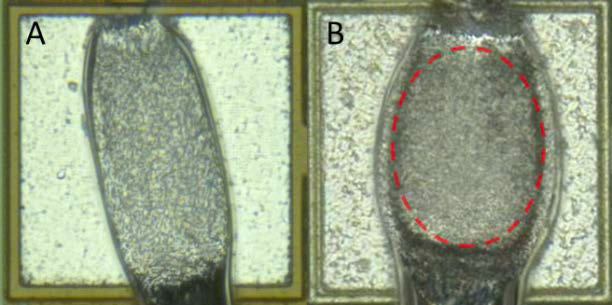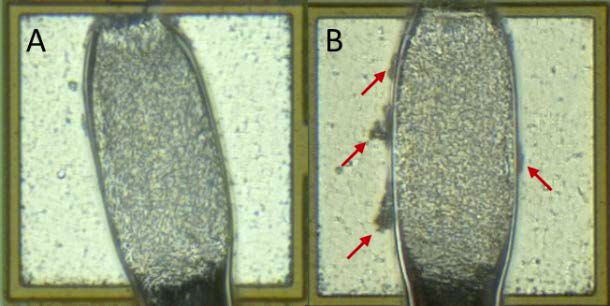In general, there are two main types of ultrasonic wire bonding: ball bonding and wedge bonding. Although thermosonic gold ball bonding is still a predominant bonding method, ultrasonic wedge bonding of aluminum wires has been recognized for its high flexibility, reliability, and cost-effectiveness—and is being used widely also. Modern wedge bonders have evolved since their early inception in 1957. With the emergence of fully automatic wedge bonders, the productivity has hence dramatically improved.
 |
1.5 mil Al Wire on Al Bond Pad A recent paper by Wenjuan Qi (R&D/Applications Engineer) and Daniel Evans (Chief Technical Officer) discusses case studies and findings regarding 1.5 mil aluminum wire on aluminum bond pad. The paper reviews the common challenges that process engineers face when developing robust processes. Wedge bond cases presented show the tradeoff between process inputs (bond force, ultrasonic energy and bond time) and the resulting bond shapes, bond appearance of black ring, burrs, and pull results. |
Examples of non-compliance and compliance are also shown to help process engineers evaluate wedge bonds and make refinements on the fly.
The experiment was conducted at room temperature with a 9000 Wedge Bonder. The wedge tool was carried by an ultrasonic transducer horn and the wire feeds through the wedge tool at a 60° angle. Two groups of experiments were designed and performed based on the different selections of bonding surfaces. Surface I was an aluminum wafer and surface II was an aluminum bond pad on a die.
Bond shape
Controlled by bond force, bond time, and ultrasonic energy through frictional energy intensity. Insufficient frictional energy intensity results in no sticks and excessive frictional energy intensity leads to bond fracture.
Black ring
Can occur in the situation of tool bouncing with low bond force. Black ring was also observed as a result of over bonding when bonding with high ultrasonic energy over a long period of bond time. Occurrence of black ring may not be valid evidence of a strong bond in this case.

Burr
A result of excessive wear of bonding interface materials. It could come from either the bond pad material or the wire. Bonding with a clean surface, high force over a short of time period at proper ultrasonic energy level is a successful way to reduce burrs.

Pull strength
The pull strength study will be improved in future studies by strengthening bond 1 or only pulling at bond 2 so that a full understanding of bonding parameters and pull strength can be obtained.
A webinar presentation was conducted by Wenjuan Qi and Daniel Evans discussing their paper. In case you missed it, download the recording here.
To learn more about Wedge Bond Process Optimization or our 9000 Wedge Bonder, download the paper and data sheet here:
Wedge Bond Process Optimization Method for 1.5 mil Al Wire on Al Bond Pad white paper |
9000 Wedge Bonder Data Sheet |
----
Wenjuan Qi
R&D/Applications Engineer
Palomar Technologies, Inc.
Daniel D. Evans, Jr.
Chief Technical Officer
Palomar Technologies, Inc.
